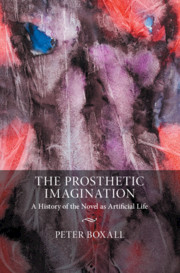Book contents
- The Prosthetic Imagination
- The Prosthetic Imagination
- Copyright page
- Dedication
- Epigraph
- Contents
- Illustrations
- Acknowledgements
- Introduction
- Part I The Body and the Early Modern State: From More to Cavendish
- Part II The Colonial Body: From Behn to Goethe
- Part III The Manufactured Body: From Wollstonecraft to Stoker
- Part IV The Modernist Body: From James to Beckett
- Chapter 6 A Duplication of Consciousness: Realism, Modernism and Prosthetic Self-Fashioning
- Chapter7 All Twined Together: Prosthetic Modernism from Proust to Beckett
- Part V The Posthuman Body: From Orwell to Atwood
- Notes
- Bibliography
- Index
Chapter7 - All Twined Together: Prosthetic Modernism from Proust to Beckett
from Part IV - The Modernist Body: From James to Beckett
Published online by Cambridge University Press: 18 September 2020
- The Prosthetic Imagination
- The Prosthetic Imagination
- Copyright page
- Dedication
- Epigraph
- Contents
- Illustrations
- Acknowledgements
- Introduction
- Part I The Body and the Early Modern State: From More to Cavendish
- Part II The Colonial Body: From Behn to Goethe
- Part III The Manufactured Body: From Wollstonecraft to Stoker
- Part IV The Modernist Body: From James to Beckett
- Chapter 6 A Duplication of Consciousness: Realism, Modernism and Prosthetic Self-Fashioning
- Chapter7 All Twined Together: Prosthetic Modernism from Proust to Beckett
- Part V The Posthuman Body: From Orwell to Atwood
- Notes
- Bibliography
- Index
Summary
This chapter follows on from the last to trace the development of the prosthetic modernism discernible at the turn of the twentieth century, as it works through the modernist novel from Proust, Joyce, Stein and Woolf up to the extended late modernist work of Samuel Beckett. The chapter reads Beckett’s reception of Proustian and Joycean modernism, from his novels of the thirties and forties up to his late work Company and suggests that this reception might best be understood as a poetics of twining. Beckett offers an extended reflection on the ways in which the modernist novel performs a mode of twining, a joining together of mind with prosthetic extension; but he also enacts a specific form of untwining, which demonstrates how the novel has always shown the unbound, the disaggregated, to be a constituent part of the terms in which it conducts its binding properties.
Keywords
- Type
- Chapter
- Information
- The Prosthetic ImaginationA History of the Novel as Artificial Life, pp. 258 - 284Publisher: Cambridge University PressPrint publication year: 2020

